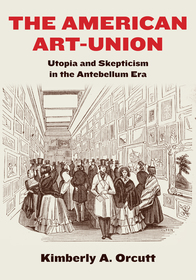
The American Art-Union
Utopia and Skepticism in the Antebellum Era
- Publisher's listprice GBP 31.00
-
14 810 Ft (14 105 Ft + 5% VAT)
The price is estimated because at the time of ordering we do not know what conversion rates will apply to HUF / product currency when the book arrives. In case HUF is weaker, the price increases slightly, in case HUF is stronger, the price goes lower slightly.
- Discount 10% (cc. 1 481 Ft off)
- Discounted price 13 329 Ft (12 695 Ft + 5% VAT)
Subcribe now and take benefit of a favourable price.
Subscribe
14 810 Ft

Availability
Estimated delivery time: In stock at the publisher, but not at Prospero's office. Delivery time approx. 3-5 weeks.
Not in stock at Prospero.
Why don't you give exact delivery time?
Delivery time is estimated on our previous experiences. We give estimations only, because we order from outside Hungary, and the delivery time mainly depends on how quickly the publisher supplies the book. Faster or slower deliveries both happen, but we do our best to supply as quickly as possible.
Product details:
- Edition number 1
- Publisher Fordham University Press
- Date of Publication 6 August 2024
- Number of Volumes Print PDF
- ISBN 9781531506995
- Binding Paperback
- No. of pages368 pages
- Size 229 mm
- Weight 746 g
- Language English
- Illustrations 87 color illustrations 585
Categories
Long description:
The first comprehensive treatment in seventy years of the American Art-Union's remarkable rise and fall
For over a decade, the New York–based American Art-Union shaped art creation, display, and patronage nationwide. Boasting as many as 19,000 members from almost every state, its meteoric rise and its sudden and spectacular collapse still raise a crucial question: Why did such a successful and influential institution fail? The American Art-Union reveals a sprawling and fascinating account of the country's first nationwide artistic phenomenon, creating a shared experience of visual culture, art news and criticism, and a direct experience with original works.
For an annual fee of five dollars, members of the American Art-Union received an engraving after a painting by a notable US artist and the annual publication Transactions (1839–49) and later the monthly Bulletin (1848–53). Most importantly, members' names were entered in a drawing for hundreds of original paintings and sculptures by most of the era's best-known artists. Those artworks were displayed in its immensely popular Free Gallery. Unfortunately, the experiment was short-lived. Opposition grew, and a cascade of events led to an 1852 court case that proved to be the Art-Union's downfall. Illuminating the workings of the American art market, this study fills a gaping lacuna in the history of nineteenth-century US art. Kimberly A. Orcutt draws from the American Art-Union's records as well as in-depth contextual research to track the organization's decisive impact that set the direction of the country's paintings, sculpture, and engravings for well over a decade.
Forged in cultural crosscurrents of utopianism and skepticism, the American Art-Union's demise can be traced to its nature as an attempt to create and control the complex system that the early nineteenth-century art world represented. This study breaks the organization's activities into their major components to offer a structural rather than chronological narrative that follows mounting tensions to their inevitable end. The institution was undone not by dramatic outward events or the character of its leadership but by the character of its utopianist plan.
Table of Contents:
"
Introduction: The Dream of Art for the People 1
1 Engravings: To Lead Taste or to Follow? 29
2 Selecting Artworks for Distribution: From Democracy to Oligarchy 63
3 The Free Gallery: Art, Anxiety, and Revolution 99
4 Distributions and Membership: ""Messengers and Missionaries of Art""? 122
5 The Bulletin: From Education to Provocation 155
6 Slowly, Then All at Once: The Demise of the American Art-Union 180
Acknowledgments 209
Appendix A: American Art-Union Resources 211
Appendix B: American Art-Union Officers and Committee of Management, 1839–51 213
Appendix C: American Art-Union Engravings Distributed to All Members 216
Notes 219
Sources Cited 253
Index 271





